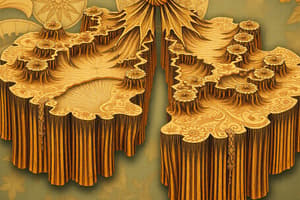Podcast
Questions and Answers
What is a fault?
What is a fault?
- A region on Earth's surface affected by convection currents
- A fracture in rocks that make up Earth's crust (correct)
- A massive slab of rock in Earth's lithosphere
- A point where two tectonic plates come together
What is the major cause of the slow, constant motion of tectonic plates?
What is the major cause of the slow, constant motion of tectonic plates?
- Convection currents underneath Earth's surface (correct)
- Tectonic plate arrangement
- Plate boundaries
- Hanging walls
Which term refers to the block of rock on one side of a fault known as the hanging wall?
Which term refers to the block of rock on one side of a fault known as the hanging wall?
- Lithosphere
- Convection current
- Plate boundary
- Footwall (correct)
How do normal faults, reverse faults, and strike-slip faults differ?
How do normal faults, reverse faults, and strike-slip faults differ?
What happens at a plate boundary?
What happens at a plate boundary?
What type of stress causes a normal fault to form?
What type of stress causes a normal fault to form?
Which type of fault forms at convergent boundaries?
Which type of fault forms at convergent boundaries?
What direction does the hanging wall move in a reverse fault?
What direction does the hanging wall move in a reverse fault?
Which type of stress causes a strike-slip fault to form?
Which type of stress causes a strike-slip fault to form?
What type of boundary is associated with the formation of strike-slip faults?
What type of boundary is associated with the formation of strike-slip faults?
Flashcards are hidden until you start studying
Study Notes
Earth's Crust and Tectonic Plates
- Earth's crust is made up of giant slabs of rock in the lithosphere
- There are 7 major tectonic plates: African, Antarctic, Eurasian, Indo-Australian, North American, Pacific, and South American
- Minor tectonic plates also exist
- These plates are in constant motion due to convection currents underneath Earth's surface
- The place where two tectonic plates meet is a plate boundary
Faults
- A fault is a fracture in the rocks that make up Earth's crust
- There are three types of faults: normal faults, reverse faults, and strike-slip faults
- A fault has a hanging wall on one side and a footwall on the other side
Causes of Faults
- Faults are caused by stress, which is formed by pressure between two blocks of rock
- There are three types of stress: compressional, shear, and tensional stress
- Compressional stress occurs when two blocks of rock push toward each other
- Shear stress occurs when two blocks of rock slide past each other
- Tensional stress occurs when two blocks of rock move away from each other
Types of Faults
- Normal faults occur when two blocks of rock move away from each other (tensional stress)
- Reverse faults occur when two blocks of rock push against each other (compressional stress)
- Strike-slip faults occur when two blocks of rock slide past each other (shear stress)
- Normal faults form at divergent boundaries, reverse faults form at convergent boundaries, and strike-slip faults form at transform boundaries
Studying That Suits You
Use AI to generate personalized quizzes and flashcards to suit your learning preferences.




